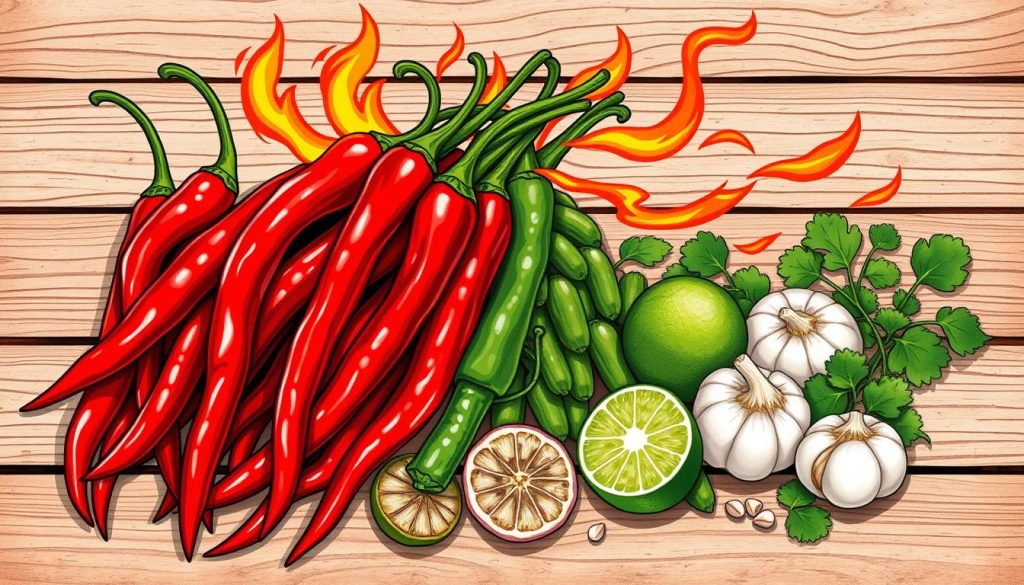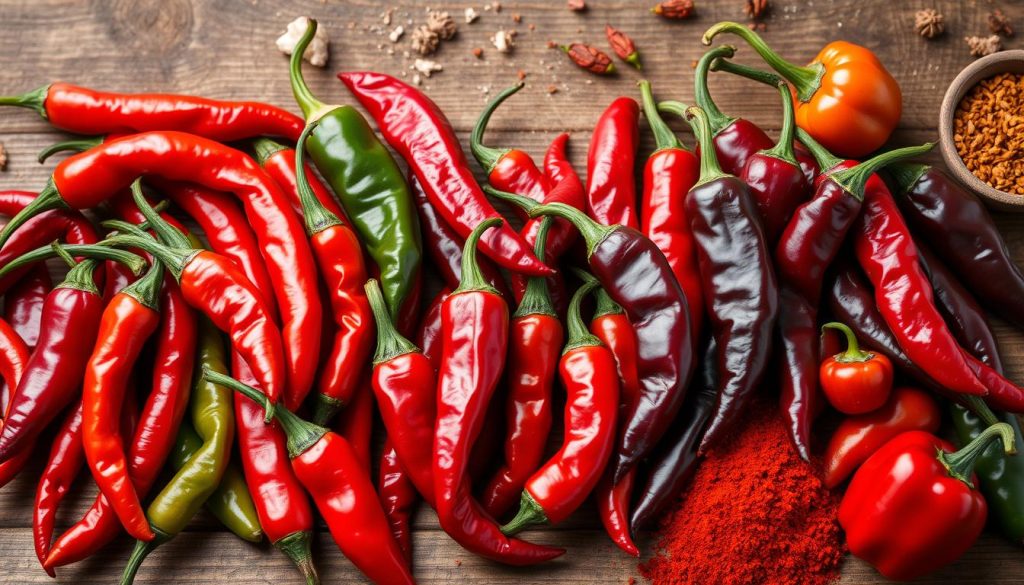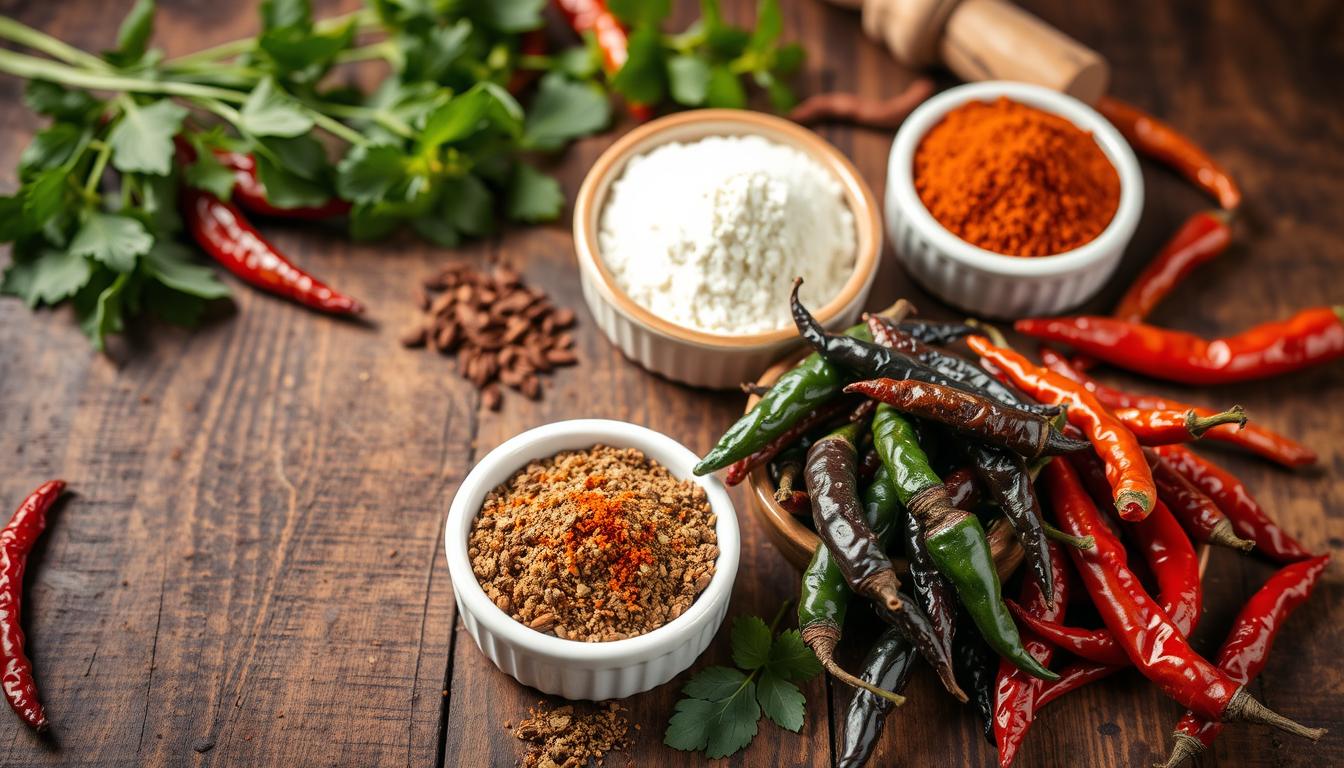Welcome to your ultimate resource for árbol chile substitutes! If you’ve ever found yourself in a situation where you can’t find árbol chiles for your cooking needs, this guide is crafted just for you. You will discover essential alternatives in this article that will maintain the authentic flavors of your dishes, ensuring your culinary creations remain vibrant and spicy.
Knowing what you can substitute for chile de árbol is crucial, especially when these flavorful peppers are absent from your local market. Furthermore, we will explore various spicy pepper substitutes that blend seamlessly into your recipes, enhancing your overall cooking experience with árbol chiles. With a Scoville heat range of 15,000-30,000, these chiles are significantly hotter than jalapeños, meaning that the right substitute is vital to achieving the heat level you desire. Read on to adapt and spice up your meals effectively!
Introduction to Árbol Chiles
Árbol chiles are thin, vibrant red dried peppers from Mexico. They belong to the Capsicum annuum species. Known as “rat tail chiles” or “bird’s beak chiles,” they are loved for their bright color and sharp heat. With a Scoville Heat Unit (SHU) rating of 15,000 to 30,000, they are hotter than jalapeños. This makes them a key ingredient in Mexican cooking.
Their unique look, with woody stems and bright colors, makes them popular in many dishes. They are often used in sauces and salsas. This adds depth to flavors and shows off Mexican cuisine’s essence.
Exploring Mexican cooking means learning about árbol chiles. Their special taste works well with many foods. This lets chefs make dishes that truly capture Mexican culture’s spirit.
| Chile Type | Heat Level (SHU) | Culinary Uses |
|---|---|---|
| Árbol | 15,000 – 30,000 | Sauces, Salsas |
| Ancho | 1,000 – 1,500 | General Cooking |
| Mulato | 1,000 – 2,000 | Meat Dishes |
| Chipotle | 2,500 – 10,000 | Salsas, Garnishes |
| Guajillo | 5,000 – 8,000 | Oaxacan Dishes, Moles |
Understanding the Flavor Profile of Árbol Chiles
Árbol chiles have a bright, acidic taste with a hint of grassiness. They also have a nutty flavor and a moderate spiciness. This makes them great for adding depth to many dishes without overpowering them.
These chiles are perfect for adding a vibrant kick to your food, similar to cayenne pepper. Unlike sweet chiles, árbol chiles offer a sharp, clean heat. They pair well with sour flavors like tomatoes and citrus. They also complement proteins like chicken and pork, enhancing the taste of your meals.

Árbol chiles are versatile in the kitchen. They’re great in salsas, chili, and hot sauces. Even a few peppers can make a big difference in heat. You can also dry them to make powders or rehydrate them for fresh use. Storing them right helps keep their flavor, though some may fade over time.
Knowing how árbol chiles taste lets you make your dishes more exciting. They bring bold flavors and a nice heat to every bite.
What Can I Substitute for Chile de Árbol Guide
Looking for árbol chile substitutes? You have several options that can work well in your recipes. Each one has its own heat level and taste, so pick the right one for your dish.
Popular Substitutes for Árbol Chiles
Here are some top substitutes for árbol chiles:
- Cayenne Chile: Cayenne pepper is very hot, with 30,000 to 50,000 Scoville heat units. It’s a great choice if you like spicy food.
- Guajillo Chiles: Guajillo chiles are sweeter and milder than árbol chiles. They add depth to salsas and sauces without being too strong.
- Dried Pequin Chiles: Pequin chiles are spicier than árbol chiles. They’re perfect for those who love a strong kick.
- Fresh Serrano Chiles: Fresh serranos have different heat levels. They offer a unique taste experience.
- Japones Pepper: Japones peppers have a similar heat to árbol chiles (15,000 to 30,000 SHU). They’re a great match for many dishes.
Considerations When Choosing Substitutes
When picking a substitute for árbol chiles, think about these things:
- Heat Level: Pick a substitute that matches the heat you want. Guajillo chiles are good for milder dishes.
- Flavor Balance: Choose a substitute that fits the dish’s taste. Cayenne or dried pepper flakes can add a versatile touch.
- Cooking Method: Some substitutes, like whole dried chiles, need to be soaked. Make sure to adjust your cooking method.
Knowing these tips will improve your cooking. It will also make sure your dishes taste great when you use árbol chile substitutes.

Heat Level Comparison: Árbol Chiles vs. Other Chiles
Knowing the heat levels of different chiles is key when choosing the right one for your dishes. Árbol chiles have a heat range of 15,000 to 30,000 SHU. This makes them quite spicy but not as hot as cayenne chiles, which can be between 30,000 and 50,000 SHU.
Here’s a look at some popular chiles and their heat levels:
| Chile Type | Scoville Heat Units (SHU) | Spice Level |
|---|---|---|
| Jalapeño | 2,500 – 8,000 | Mild to Moderate |
| Guajillo | 2,500 – 5,000 | Mild |
| Árbol | 15,000 – 30,000 | Hot |
| Serrano | 15,000 | Moderate to Quite Hot |
| Cayenne | 30,000 – 50,000 | Hot to Quite Hot |
| Chiltepin | 50,000 – 100,000 | Very Hot |
Remember, jalapeños are much milder than árbol chiles. Using árbol chiles in place of milder peppers can make your dishes too spicy. It’s important to balance the flavors and heat in your recipes for everyone’s enjoyment.
How to Use Substitutes in Your Recipes
Adding substitutes for árbol chiles to your cooking can make your dishes more flavorful and spicy. It’s important to know how to prepare chiles for recipes, whether you use dried or fresh ones. This knowledge helps both chefs and home cooks to try new things.
Cooking Techniques for Substitute Chiles
When using dried chiles in cooking, soaking them in warm water is key. This makes their flavors come alive, perfect for marinades and salsas. After soaking, you can puree or chop them for a smoother texture in your dishes. Grinding dried chiles into powders is also great for seasoning meats or sauces.
Fresh chiles are vibrant but can vary in heat. Adjust how much you use based on their spiciness. Always wear gloves when handling chiles to avoid skin irritation.
Combining Chiles for Flavor Complexity
Mixing different chiles can add more depth to your dishes. You might blend árbol chiles with milder ones like anchos or pasillas. This creates a richer taste in sauces, salsas, and marinades.
For example, combining six to ten dried árbol chiles with roma tomatoes and tomatillos makes a spicy salsa. This salsa is easy to make and can be frozen for up to four months, making it perfect for meal prep.
| Ingredient | Quantity |
|---|---|
| Dried árbol chiles | 6-10 |
| Roma tomatoes | 2 |
| Small tomatillos | 4 |
| Garlic cloves | 2 |
| Yellow onion | ½ cup |
| Cilantro | ½ bunch |
| Lime (juice) | 1 |
| Kosher salt | to taste |
Try these techniques and mixtures in your cooking with substituted chiles. It adds flexibility and creativity to your dishes.
Where to Find Árbol Chiles and Their Substitutes
Finding árbol chiles is easy if you know where to look. Most Mexican grocery stores carry these chiles. You can also find them in the international foods section of big supermarkets. This makes buying árbol chiles simple and convenient.
If you can’t find them locally, try online chili stores. Many websites specialize in gourmet spices and ship árbol chiles right to your door. They also offer alternatives like cayenne, guajillo, and serrano chiles, giving you more choices in the kitchen.
When buying árbol chiles or substitutes, look for high-quality dried ones. The taste of dried chiles greatly affects your dishes. So, choosing quality is key. Whether for a spicy salsa or other recipes, knowing where to find chiles will improve your cooking.
Here are some tips for finding árbol chiles and their substitutes:
- Check local Mexican grocery stores for fresh supplies.
- Visit the international foods aisle of supermarkets for convenience.
- Explore online retailers for versatile options and specialty spices.
- Examine the quality of dried chiles to ensure optimal flavor in your recipes.
Conclusion
In summary of árbol chiles, you’ve learned about their fiery nature and uses in cooking. You now know how to pick the right substitutes for them. This guide helps you use árbol chiles in your recipes.
Thinking about chile substitutes shows how flexible cooking can be. You can choose milder peppers or try new ones to make your meals exciting. Always pick a substitute that fits your taste and heat preference.
Cooking with árbol chiles can make your dishes both tasty and healthy. They can help speed up your metabolism and boost your immune system. As you try new recipes, you’ll see how the right peppers can turn simple foods into amazing dishes.
Source Links
- https://www.diversivore.com/the-pantry/arbol-chilies/
- https://www.curiouscuisiniere.com/dried-mexican-chile-peppers/
- https://zestyhut.com/2024/10/02/arbol-chili/
- http://dondayinsma.com/2017/06/26/chile-peppers-guide-dried/
- https://spicesinc.com/blogs/guide-mexican-dried-chiles?srsltid=AfmBOornVPPkbPfRl9FkTzKu3DHWbmvvsjJlhtZtWVye1XtBSaXUavbt
- https://spicesinc.com/blogs/guide-mexican-dried-chiles?srsltid=AfmBOoq2_Ymh3yBSnDIyC0ULK2tS_CJTPcEXdE_V8oqO0hQKoKy3f_05
- https://www.chilipeppermadness.com/chili-pepper-types/medium-hot-chili-peppers/chile-de-arbol-chili-peppers/
- https://www.seriouseats.com/serious-heat-chile-substitutions
- https://pepperscale.com/chile-de-arbol-substitute/
- https://brokebankvegan.com/chile-de-arbol/
- https://spicesinc.com/blogs/guide-mexican-dried-chiles?srsltid=AfmBOooOIO23pSqOXyZOmuT4XgnLa1FV0r0NU_jLIg4Ndm9cG-in0Nh1
- https://www.tastythais.com/hot-chili-peppers-substitutions/
- https://whatsgabycooking.com/traditional-salsa/
- https://www.holajalapeno.com/chile-de-arbol/
- https://www.cozymeal.com/magazine/substitute-for-guajillo-chiles
- https://casadesante.com/blogs/gut-health/are-chile-de-arbol-peppers-low-fodmap?srsltid=AfmBOooil_OjYwNpGue_WqYXn_GivH7VzNPScC9-4jGid4y984mxPjt6
- https://muybuenoblog.com/mexican-chiles/
